In this Crystal Project content you will learn growth stats. Stats is one of the most important systems in this game. Therefore, we recommend that you read the guide carefully and act accordingly.
Crystal Project Stat Growth
How to optimally select for stat growth levels based on a “highly biased” interpretation of how stats affect gameplay.
Stats & Growth Adjustment
Crystal Project has a pretty unique and cool stat system in that it allows you to control the stat growth of any of your characters at a very micro level. Want a Reaper with 60 levels of warrior? Maybe a Summoner with 10 levels of Assassin and 50 levels of Mimic. All things are possible.
Each class has its own unique growth pattern. If all stats were equal these would be roughly equivalent to one another in terms of raw value, with each class gaining between 24 and 26 total stats at each level. You can see this growth pattern expressed on the class selection screen via a series of stars next to each stat.
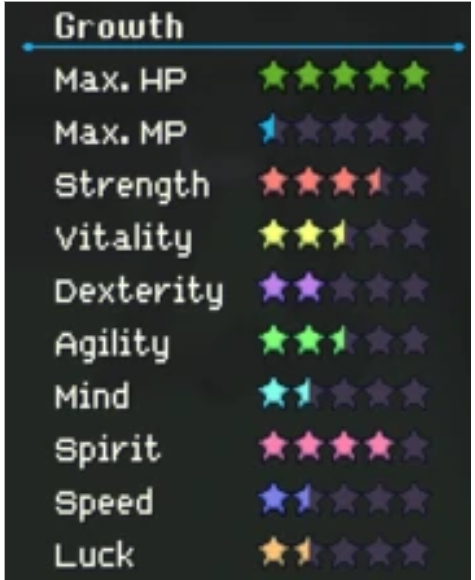
Stats have two functions. First they provide a bonus unique to each stat:
- HP – Alived-ness amount
- MP – Pew pew pool
- Strength – Defense pierce
- Vitality – Defense multiplier
- Dexterity – Crit chance & Crit damage
- Agility – Accuracy & evasion
- Mind – Magic defense pierce
- Spirit – Resist multiplier
- Speed – Turn Timer reduction
- Luck – Status application, streak modification
Second they drive class ability damage, with each class using a different core damage stat. There is quite a bit of overlap between these damage stats that can be generalized as:
- Warriors use strength
- Rogues use dex in melee and agility at range
- Mages use mind
- Healers use spirit
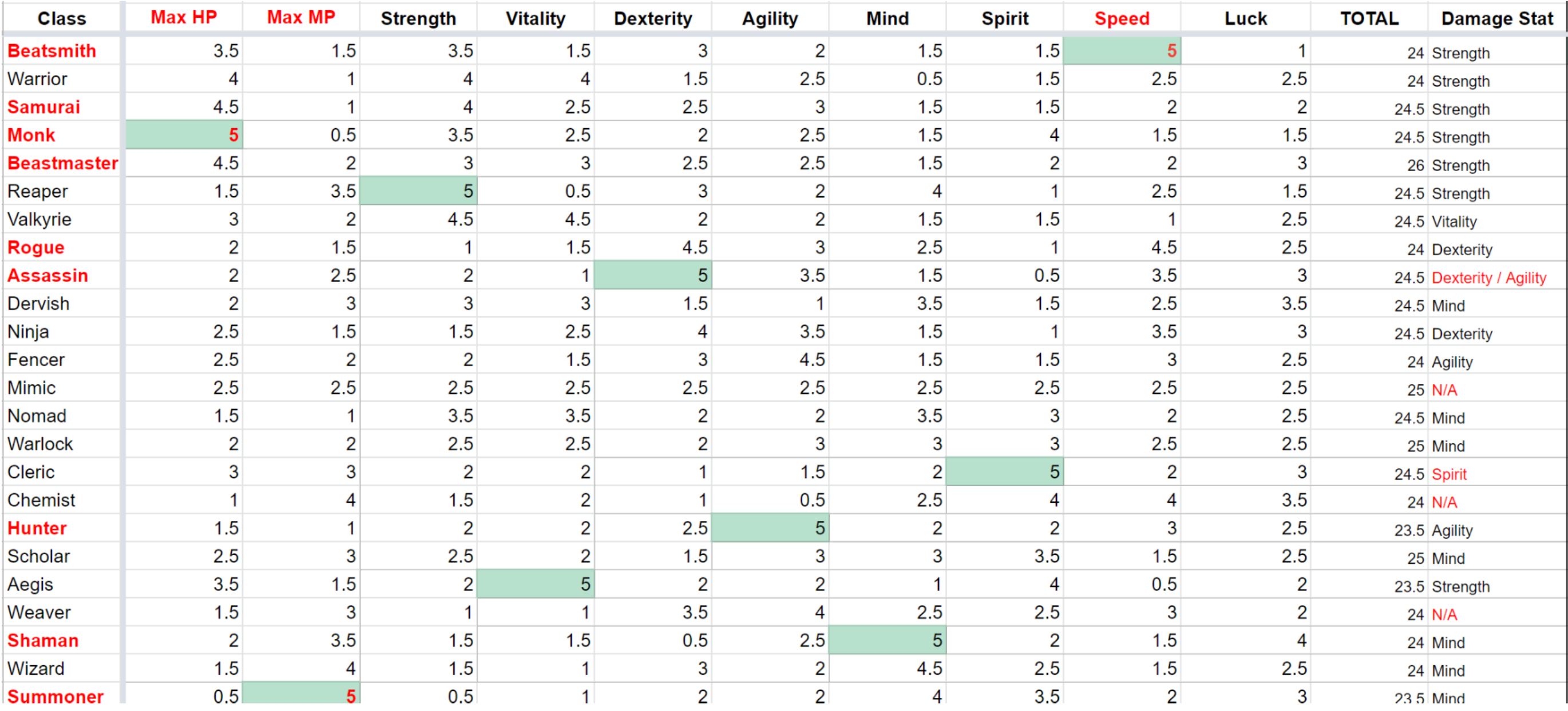
Stat growth can be changed in the capital city just south of the Gaea Temple, in the leftmost building in the middle city tier.
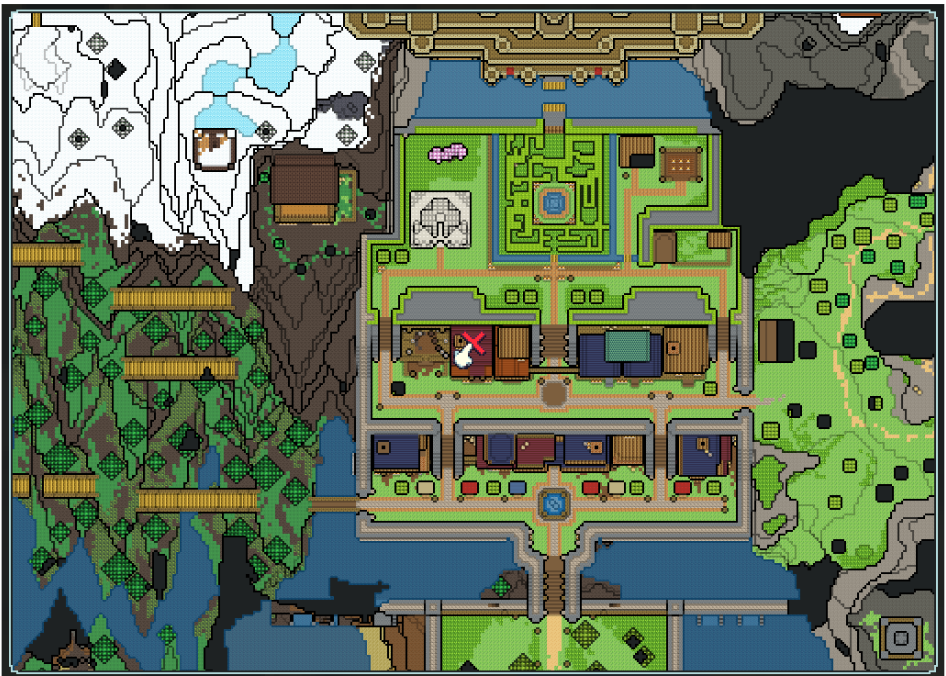
Cost scales based on the number of level conversions being purchased, but in general you can expect to spent about 7.5G for 60 levels in a single class.
Starting Point
Things get really spicy when you realize that stats are not all of equal value. The impact of increased base HP, base damage or TT reduction when compared to something secondary like defense pierce is pretty huge. This gives us a solid starting point that we can use to drive stat growth decisions.
The complexity of this system, with different classes getting different amounts of stat but assignable in any quantity to a character regardless of their leveling experience, has led me to the conclusion that the best approach to optimizing growth revolves around managing a series of priorities. The rest of this guide is going to be about around narrowing in on the specifics of this strategy.
Priorities:
- Speed for more turns
- Base HP & MP for being alive and/or useful
- Base damage stat for bigger number
Caveats: HP & MP Growth
HP growth loses a fair amount of value in the late game due to a few factors:
- Late game areas and bosses use far more AoE attacks, so having one unit with a much higher HP pool doesn’t do much to change how many resources need to be consumed to recoup after taking a hit. You are going to use a group heal of some sort.
- There are a multitude of very powerful ‘Survive one hit’ style passives available to any character. These mechanics are absolute and don’t depend on variance.
- Even a fully kitted and specced tank isn’t going to survive two big attacks in a row without healing. This is due to how most bosses used mixed damage and tanks can only really successfully itemize against physical attacks.
Because of this I personally believe the best stat growth pattern selects for HP growth only up until a certain point. How you define that point will vary based on your own personal risk preference, but I tend to try to ensure every character can survive one boss AoE without consuming their survival passives. I generally use 1.1k HP as a hallmark for this, but it is dependent on having end-game gear so you may need to adjust your targets accordingly. It is also worth noting that most plate wearers will have HP available on their BiS gear items, which further lessens the value of HP via stat growth.
MP Growth patterns are pretty similar in principle, with the summoner as a notable standout. (Summoners tend to focus much more single mindedly on MP due to the singularly powerful, consumable and non-scaling nature of their spells).
Caveats: Defense & Multipliers
Looking at the description for stats, you might think that “defense multipliers against static pierce!? I can be immortal!,” I know I did. Defense as an archetype, however, relies pretty heavily on the dominance of the holy trinity (Tank/Healer/DPS) and therefore on the power of threat management.
We have the tools to manage threat, but the frequency and frank brutality of boss magic AoE’s sort of breaks the rest of the strategy. Having a tank maintain threat becomes pointless pretty quickly when the crew dies every other turn to area attacks. It is even further trivialized by how poor resistance gear is for tanks – you will find that it’s not ‘everyone but the tank’ who dies to boss aoe, but just everyone.
For this reason I have heavily de-prioritized mitigation stats and prioritized in their place raw HP. This is both more universal (eg doesn’t require an equip passive to utilize well) and has a better synergy with the variety of survive-one-hit passives and auto-res buffs.
Caveat: Agi & Accuracy
Accuracy scales 1:1 with a characters Agility and is compared to your opponents level when calculating hit chance. Values over 100% hit chance are wasted, and values under that amount can be applied to your average output as a percent reduction equal to the chance an attack misses. All of these values assume you are in combat against an equal level opponent – deviation in that level comparison one way or another doesn’t change the rate at which agi converts to damage but instead increases or decreases the amount of agi needed to hit that 100% mark.
The interesting thing, however, is that this conversion scales directly with the primary stat multiple on a typical attack. As a point of reference, most physical attacks vary between 0.5x to 1.5x of the units primary stat. The end result of this is that:
- Non-agi characters with low primary stat conversion will get about 0.22 bonus damage per agi added
- Non-agi characters with high primary stat conversion will get about 0.44 bonus damage per agi added.
- The break even point (eg when 1 point of agility is roughly equal to 1 point of the units primary stat) is around 3x. I think the only ability this applies to is the Reaper’s Guillotine.
- Agi characters benefit from bonus hit chance in the exact same way non-agi characters do, which means high converting attacks like Snipe get something like 3.5 more stat value than any other class.
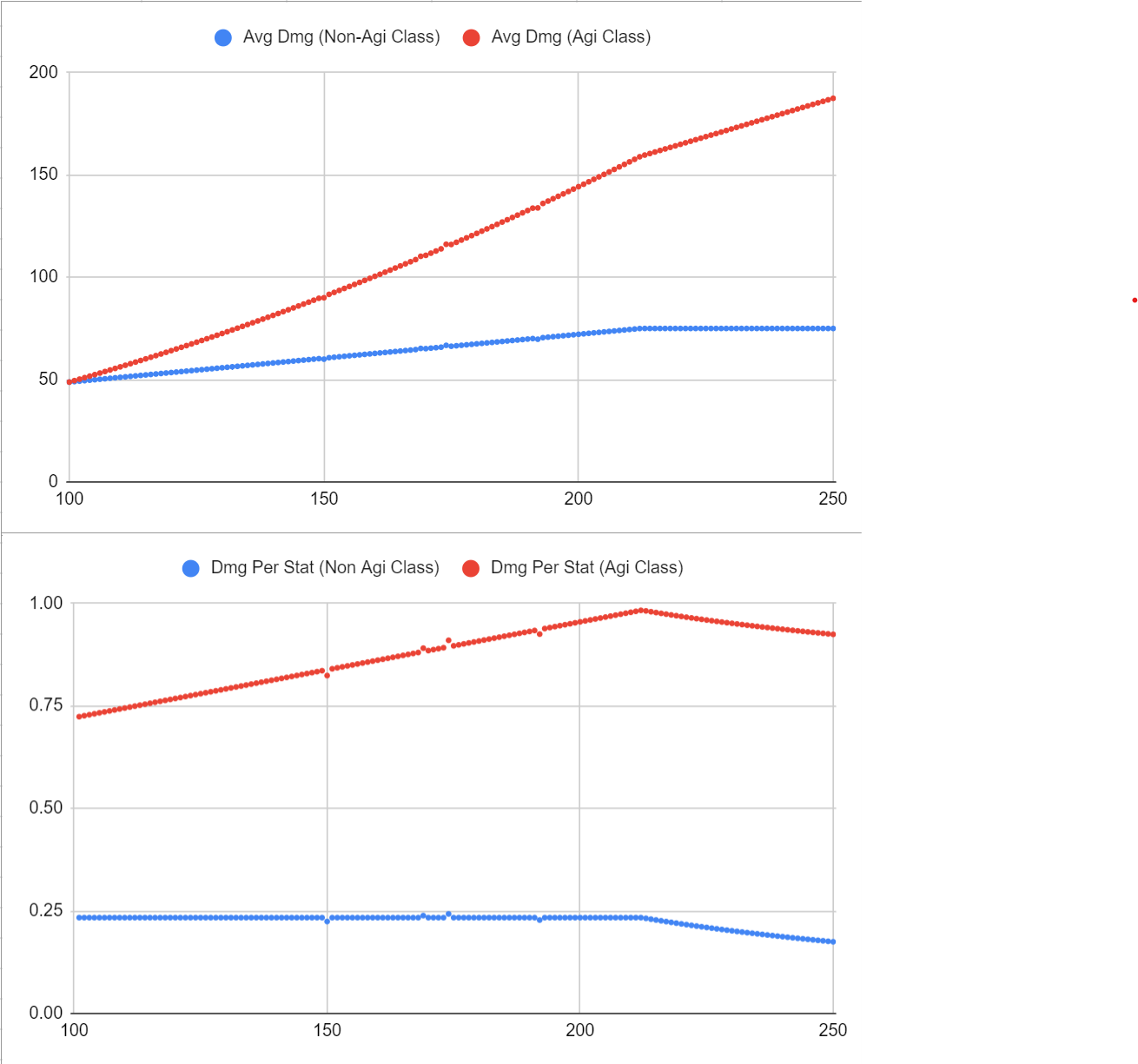
Caveats: Non-Dex Crit
Adding Dex to a class that doesn’t gain base damage through it, but is still inherently physical, will still benefit from the additional crit chance and damage. Upon analysis, however, the total value gained is pretty unimpressive. Though the actual damage contribution per dex changes slightly depending on your total dex, it averages out at about 1 bonus damage for every 9 dex. It’s not negligable, but it’s not worth investing in.
For classes that do use Dex as a base damage stat (Assassin, Fencer, Rogue, etc), the additional factor of Crit more than doubles the relative value of adding Dex over any other stat. This simply reinforces the rest of the advice here.
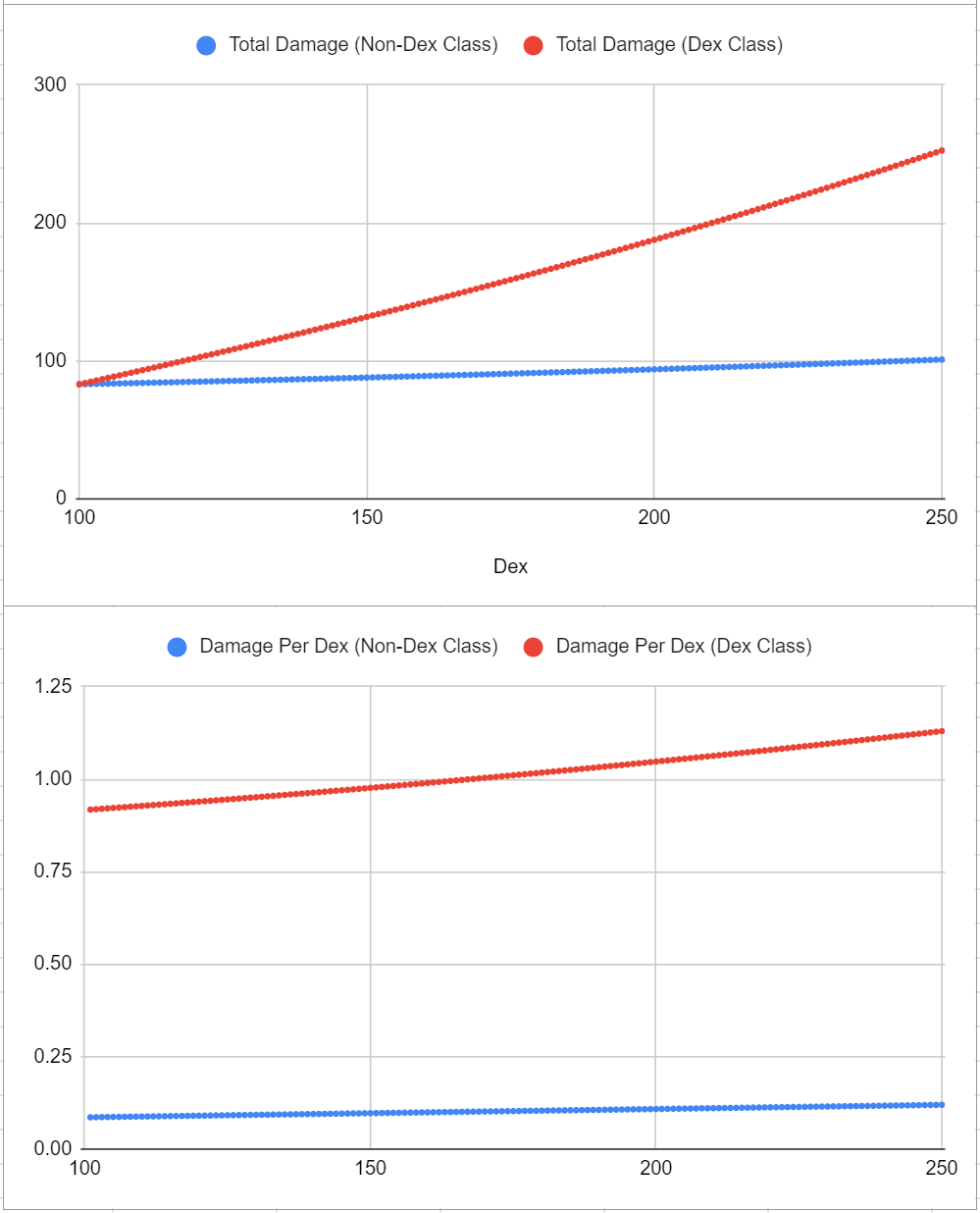
Caveats: Speed & TT
Speed is an interesting stat. Increasing the speed of a character reduces it turn timer, which influences both the order and number of actions in a combat. On paper it is the most egregiously overpowered stat in the game. However, the relationship between TT and speed is lossy; the more speed you have, the more it takes to change the turn timer. Or, to put it a different way, the more speed you have the less valuable getting more of it is. Compared to something static in value like base damage, this points us in a pretty clear direction for stat growth: Identify the saddle point in speed growth curve, get that much speed and then stop.
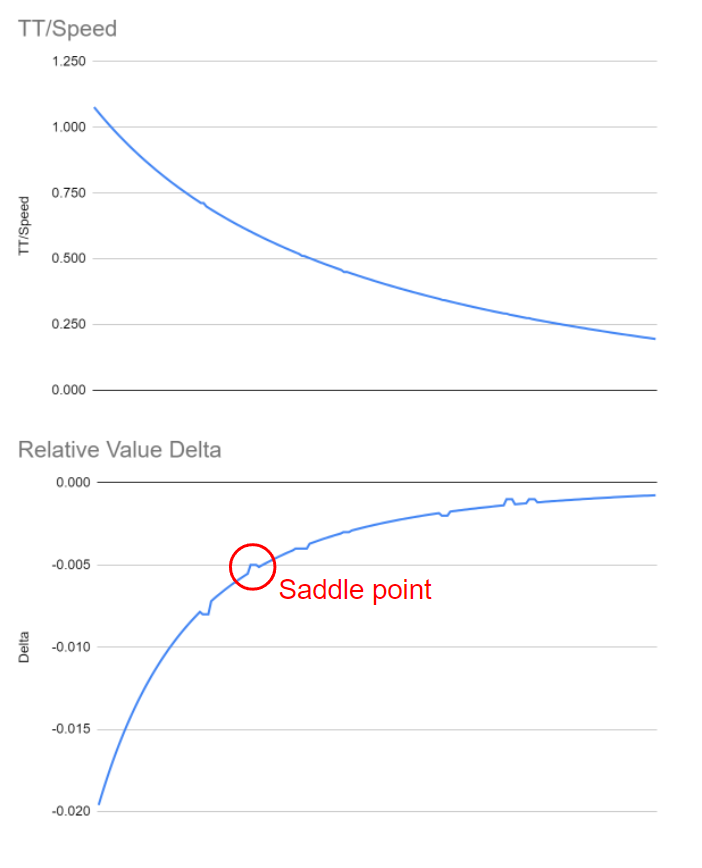
- Under 100 speed you get more than 1 TT reduction per stat.
- Between 100-140 speed the TT reduction scales down to 0.5 per stat.
- Between 140-160 the TT reduction scales down further to 0.33 per stat
- Finally between 160 and 220 it scales down again to 0.1 per stat.
If you zoom in far enough on the delta between these relative value changes, it appears as if the saddle point sits around the 0.33 reduction per stat, or at 160-165 Speed.
(I have included a link to the data table and sheet that I used to find these values near the end)
Note: This kind of flies in the face of conventional wisdom on the game, and 165 speed is absolutely trivial to hit. If you are using a class that has any of amount of inherent speed you likely won’t have to pay attention to the stat at all. If turn order (rather than turn efficiency / action count) really matters to your comp (Hello Dream Hunters & Coup De Grace debuffers), you will need to take the time to find the average speed of bosses you face and then make sure you are above that when setting your speed target.
Revised Priorities
This now leaves us with a refined priority list.
- Speed up to 165.
- Base HP up until you can survive a hit from bosses you face. “Some units (Sleep Hunter / No threat rogue) may want to remove this priority”
- Base MP up until your mana pool persists across a single boss combat.
- Base damage stat.
Putting it All Together
So at this point we have a series of goals / priorities, and an understanding of how much of any given stat a level in a class produces. The process now becomes about identifying classes which produce the maximum number of stats that fall into our prioritization, and ignoring all other stats. Google sheets makes quick work of questions like this. Let’s run through an example.
Imagine we are building a Reaper DPS unit. Reapers use Strength as a primary damage stat and don’t use MP beyond a few infrequently used buffs, so we can say the stats that matter are: HP, Str, and Speed. If you add the stat per level contribution of the classes again, after culling the irrelevant, you can see that until your priorities shift, levels in Beatsmith are the most efficient.
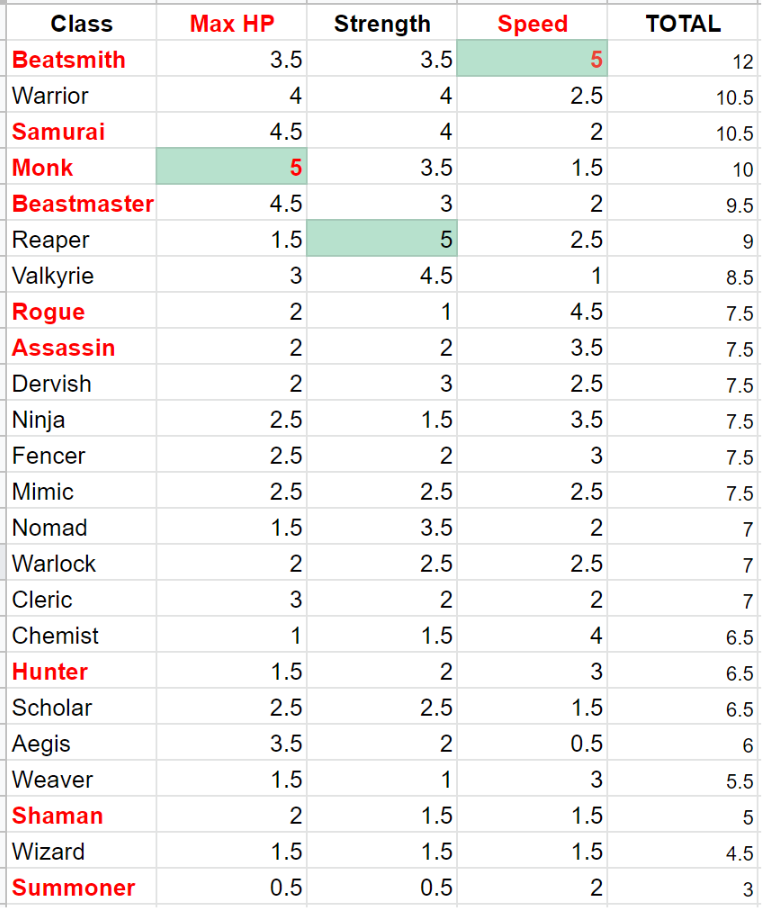
Once the first stat priority goal has been achieved (Speed >= 165), we can cull that stat from the evaluation and re-assess the total contribution from each class. Thus, our next class would be Samurai.
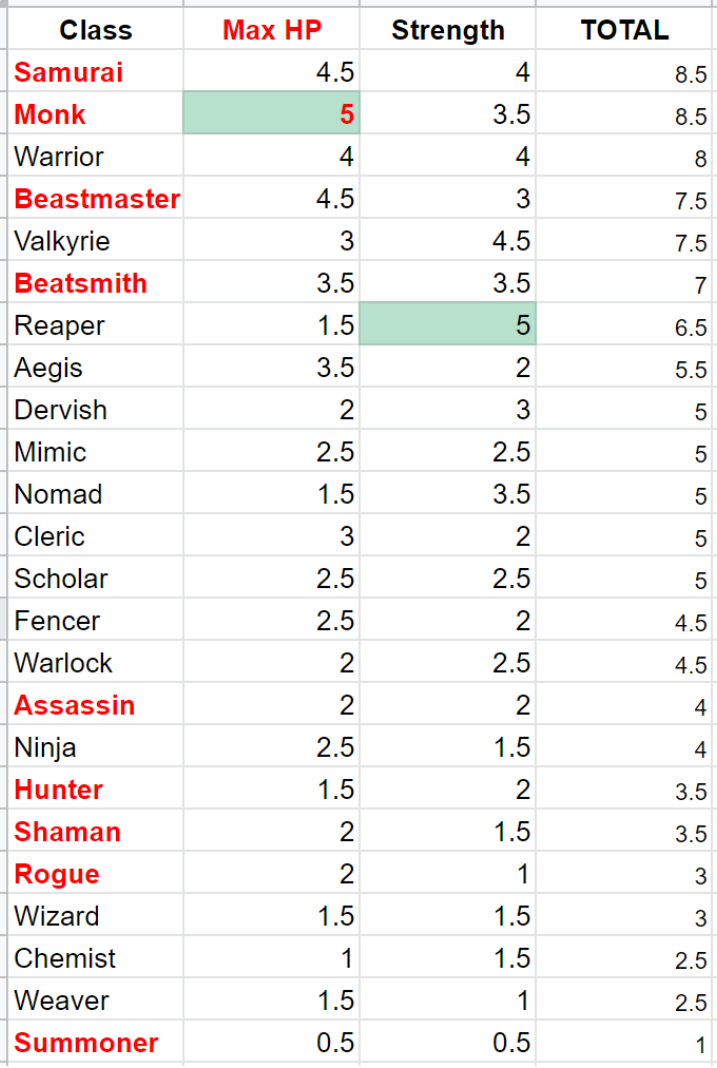
Finally, once both the HP and Speed goals have been met, Reaper, with 5 Str per level, should finish out the path.
Stats and Team Composition
Before getting in a fight you might want to improve your team as a whole and have a strategy before fighting big baddies.
The goal here is not to tell you “this is the most optimal, play this” but rather to give you the building blocks to help you make your own party of capable fighters.
Make Your Own Goals/Strategy
At first you will want to have a general goal for your team. This goal will constantly be challenged, questioned and threatened by more and more difficult combat encounters (which is ok, don’t worry).
For example let’s say our player wants to have a very traditional and balanced party composition and have each party member filling a single role.
In this case, the goal is to define each party member role and to maximize their effectiveness at that specific role. The healer is here to heal, the tank is here to tank, the mage is here to deal magical damage and the last one is here to deal physical damage.
From there, our player will know better how to choose classes, passives and equipment for each of the 4 party members. The healer might start on a Cleric or Warlock class, the tank on a Warrior or Monk class and so on.
Now let’s say our traditional and balanced team is hitting a brick wall because a boss uses a tactic the party can’t handle. For instance, the boss uses exclusively group-wide attacks with a vast majority of physical attacks and occasional party-wide magic.
Our new goal is to have the entire team able to withstand the constant barrage of party-wide attack while dishing constant damage to finish the fight before going out of resource (usually MP first then HP).
Solutions are plenty but for example the tank and the physical damage dealer could learn the Counter passive from the Monk class to effectively counter-attack every party-wide physical attack. The healer and the mage could both learn the Storm Stance from the Wizard class to also counter-attack with lightning spells everytime they are hit.
From there we can make sure to improve the physical defense of our team enough for them to survive the hit and eventually use tools like Eye Gouge from the Rogue class to blind the boss before it attacks our party.
You see with this example that formulating a clear goal helped us dealing with our brickwall and the boss ended up being a cakewalk all of a sudden.
Choose the Right Classes
As you progress through the game you will unlock many more classes than the starting 6. Across the board all classes have their use with some being more versatile (typically the first 6 are excellent classes that fit more traditional playstyles) than others (some classes can have more specific playstyles).
It’s important to note what impact choosing a class has on your adventurers. Your main class defines the followingo:
- equipment based on that class (for example a Warrior has access to varied weapons whereas a Cleric has a much more limited range)
- the class commands (skills, spells and stances)
- how your stats grow on leveling up (more on that in the next section)
Your character can then equip any passive they learned from any class on top of gaining access to commands from a single other class (and only their commands, the stat growth and the equipment accessible are not influenced).
Thinking About Your Character’s Stats
Upon leveling up, your adventurer gains stats based on their currently equipped class. You can tweak this growth in a building in the capital city (you get access to it fairly early on in the story and you can’t really miss it don’t worry).
When you pick a class, you can see a star rating of every stat in the game for that specific class: this represents the class’ stat growth.
There is no real good or bad way to go here but usually it’s best to specialize your characters in a few key stats as much as you can. You can see in the tooltip of the commands you use what stats they use in their calculation.
On top of impacting commands directly, stats also have a bonus effect as follow:
- Strength: Increases Defense Pierce (meaning that your attacks are more effective against high Defense enemies)
- Vitality: Gives a multiplicative bonus to your Defense and reduce the amount of damage taken per turn by status like Poison, Bleed and Burn
- Dexterity: Increases your chance to inflict critical hits and the damage dealt by critical damage (be careful this is mostly true only with physical attacks)
- Agility: Increases Accuracy and Evasion
- Mind: Increases Resistance Pierce (meaning that your spells are more effective against high Resistance enemies)
- Spirit: Gives a multiplicative bonus to your Resistance and increases the amount of health recovered from heal per turn effects like Regen or Chakra
- Speed: The higher the speed the faster your character can act and the more turns they will have comparatively to other persons in combat
- Luck: Generally helps against bad luck for everything related to a % chance and help with having better rolls of damage when you have Variance
Match Your Team with Good Gear and Passives
Now that you know what class and what stats you want each of your characters to have you can start thinking about gear and passives.
Generally you will want to make the most out of your characters and play on their strength. For example: if your tank is not meant to deal high amount of physical damage but you still want them to do cheap damage regularly you could give them the Counter passive and a dagger inflicting 1 turn of Bleed or Poison on hit so that they constantly apply Bleed or Poison to enemies attacking them with physical attacks.
Sometimes you might want to adapt to the situation and change your passives and gear accordingly. Let’s say an enemy has particularly devastating fire magic and is very frequent in the area you are exploring. Then you might want to maximize the Resistance of each of your party members and see if you can mitigate fire damage through clever use of gear.
TL;DR
Summary:
- Speed loses value fast, only take it up to 165
- Survival passives are better than stacking HP/Def
- Leveling for accuracy on non-Agi units isn’t worth it.
- Beatsmith is the best class in the game because everyone cares about HP and Speed
- Find the class that adds 5 to your damage stat and try to use as much of it as possible
Build Archetypes
Strength leveling path:
- Beatsmith until 165 speed
- Samurai until HP target is met
- Reaper with rest
Dex leveling path:
- Beathsmith until 165 speed
- Assassin with rest
Agi leveling path:
- Beathsmith until 165 speed
- Samurai until HP target is met
- Hunter with rest
Mind leveling path:
- Dump it all into Shaman. It’s universally good.
Spirit leveling path:
- Chemist until 165 speed
- Rest into Cleric
Crystal Project Stats FAQ
Question:
I am reading the guides and one thing I noted was the stats guide. Is there a way to repec the stats so I can min max my characters or am I stuck with the level I gain with the starting classes before unlocking the best classes for stat gains.
Answers:
- In Capital Sequoia you can respec what levels you’ve gained, so you can min max your stats.
- And note that the overwhelming majority of your stats come simply from your current class and level — the ‘innate’ stats you acquire through level up gains are a relatively small fraction of your totals.
- So, while there is benefit to be gained from min maxing your level up gains, shuffling those around isn’t a major thing.
- Nothing in this game is permanent, and everything can be changed. Sometimes, fixing a mistake can be expensive, such as buying an item you neglected to steal from a boss, but it can be fixed.